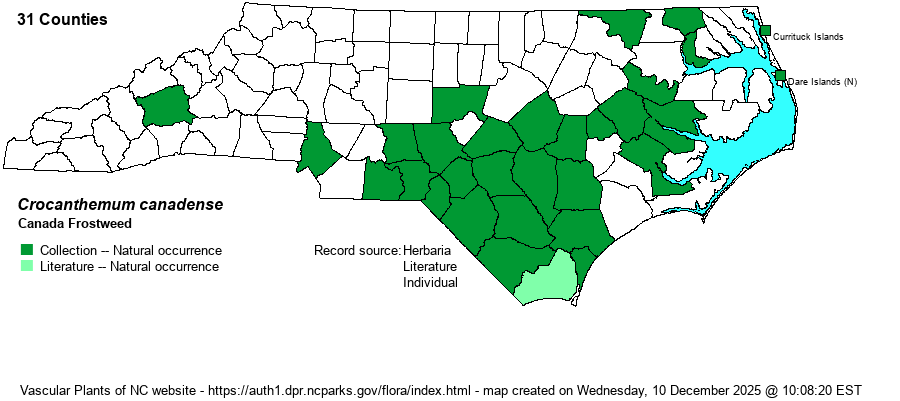| Author | (L.) Britton | |
| Distribution | Nearly throughout the Coastal Plain, particularly prevalent in the Sandhills region. Ranges sparingly in the southern Piedmont, and to one site in the southern Mountains (Buncombe County).
This species has an odd Eastern range. Though it is essentially a Coastal Plain species in NC, it ranges widely to the north of the state. It occurs -- not surprisingly owing to the scientific name -- across southeastern Canada, south to AL in the East, and to MO and IL farther west; but it is scarce south of OH and IL.
| |
| Abundance | Fairly common and somewhat widespread in the Sandhills and counties to the east, toward the southern coast. Uncommon in the northern and eastern Coastal Plain. Rare in the southeastern Piedmont, and casual in the Mountains, though this region is well within the overall range. | |
| Habitat | This is a species of sandy soil, found in open sandy woods, pine sandhills, wooded borders, fields, and some clearings. It is not a classic species, however, of Longleaf Pine (Pinus palustris)/scrub oak sandhills, though it can and does occur in this habitat. | |
| Phenology | Blooms in April and May, and fruits from June to October. | |
| Identification | This is the most numerous and most widespread Crocanthemum in the state, all other seven species being relatively rare in the state. It has an erect stem, mostly unbranched or branched from the base, reaching only about 8 inches tall. The numerous leaves (stem only) are alternate, ascending, lanceolate to elliptical, only about 4/5-inch long and 1/4-inch wide, and quite pubescent. The tip of a stem has only one or two flowers, each of the 5 petals being medium yellow, obovate, and the spread flower is about 1-inch across. Several other species in the genus occur in its range, but only C. carolinianum and C. nashii are somewhat similar. The first of these has only 2-4 stem leaves, as opposed to many more (often 10-20) in C. canadense, plus it also has basal leaves that are lacking in C. canadense. If flowers are visible, they are noticeably larger in C. carolinianum, often 1.5 inches across, and usually 2 or more flowers are present. C. nashii, very rare in NC, has the ovary and capsule(s) "densely stellate pubescent" (Weakley 2018), versus glabrous in all other members of the genus. | |
| Taxonomic Comments | None
All NC species of Crocanthemum were formerly placed in the genus Helianthemum. | |
| Other Common Name(s) | Canada Sunrose, Longbranch Frostweed | |
| State Rank | S3 [S4] | |
| Global Rank | G5 | |
| State Status | | |
| US Status | | |
| USACE-agcp | | |
| USACE-emp | | |

